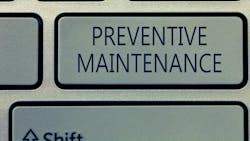Why preventive maintenance has become a strategic priority for manufacturers
What you’ll learn:
- PM revolves around performing maintenance tasks on a schedule—not in response to failures.
- Unlike predictive maintenance, PM does not rely on real-time analytics or AI.
- Today, PM is a digitally orchestrated process powered by connected tools.
Unscheduled downtime costs the world’s top manufacturers up to $1.4 trillion annually, according to Siemens last year. In sectors such as automotive, the average cost of halted production exceeds $22,000 per minute, according to Forbes.
For OEMs, keeping machines running isn’t just an operational concern; it’s a business-critical strategy. That’s why preventive maintenance is gaining traction as a proactive, data-backed method to protect assets, avoid unplanned breakdowns, and delight customers.
Smart Industry e-Handbook: Predictive Maintenance
Across industries, the average facility experiences around 800 hours of downtime a year. For one-third of manufacturers, each hour of downtime costs over $100,000 (Plant Engineering). ABB’s 2023 survey showed that two-thirds of plants have unplanned shutdowns at least once a month. These stats reveal that reactive maintenance is no longer viable.
Preventive maintenance in practice
Preventive maintenance, or PM, revolves around performing maintenance tasks on a schedule—not in response to failures. These interventions are based on usage patterns, manufacturer guidelines, or observable wear indicators, and are often managed using checklists, or computerized maintenance management systems (CMMS).
See also: The cost of downtime: Manufacturing's worst nightmare and how to solve it
Unlike predictive maintenance, PM does not rely on real-time analytics or AI. Yet, it remains a powerful, cost-effective approach for improving equipment performance and minimizing risk. Recent findings demonstrate just how impactful structured PM can be:
- A 44% reduction in unplanned downtime
- A 54% drop in product defect rates
- An 87% decrease in safety incident risk
For OEMs serious about improving reliability and reducing downtime, tracking the right metrics is essential. Preventive maintenance is no longer managed by gut feel or calendar dates alone—it is increasingly guided by a sophisticated mix of performance indicators that offer both strategic and operational insights.
Some of the most impactful KPIs include:
Overall Equipment Effectiveness (OEE): This composite metric captures availability, performance, and quality. According to Siemens, higher OEE scores correlate with 35% fewer equipment failures, making it a leading indicator of maintenance success.
MTBF & MTTR: Mean time between failures (MTBF) shows asset reliability, while mean time to repair (MTTR) tracks responsiveness. Improvements here directly impact uptime and resource efficiency.
Planned maintenance percentage: Top-performing organizations aim for 70% to 80% of maintenance activities to be proactive and scheduled, minimizing unplanned disruptions.
Maintenance cost as a percentage of asset value: Mature PM programs typically keep this below 5%, maximizing return on asset investment and controlling lifecycle costs.
See also: Navigating plant downtime risks: Choosing the right computing infrastructure
Monitoring these metrics allows OEMs to benchmark their maintenance maturity, set performance targets, and link technical improvements to business outcomes.
Tools of the trade: Tech that enables PM at scale
Preventive maintenance has evolved beyond whiteboards and paper logs. Today, it is a digitally orchestrated process powered by connected tools that allow manufacturers to operate at scale while maintaining precision and traceability. Key technologies include:
CMMS platforms: These systems form the backbone of modern maintenance strategies, tracking asset history, managing work orders, and scheduling inspections. According to Plant Engineering, 59% of facilities use a CMMS to run their preventive programs.
Mobile apps and tablets: Over 80% of technicians now access maintenance tasks directly on the shop floor through mobile devices (TechnologyAdvice). This improves responsiveness and reduces reporting delays.
IoT sensors: These devices monitor equipment conditions in real time, sending live data to CMMS platforms to trigger timely interventions before failure occurs.
Digital portals: Increasingly, OEMs are offering customer-facing platforms that enable clients to schedule service, access maintenance logs, and receive automated PM reminders.
See also: AI is taking KPIs to the next level for the factory floor
By integrating these tools, organizations not only improve asset uptime but also enhance visibility, traceability and customer experience, turning preventive maintenance into a digitally empowered capability. Customer-facing platforms now allow real-time service visibility and PM requests.
Real-world preventive maintenance in action
Preventive maintenance does not require predictive algorithms or advanced condition monitoring to make an impact. Across sectors, organizations are achieving significant gains through disciplined, time-based routines and structured digital tools.
Consider these examples:
A heavy equipment OEM implemented runtime-based PM schedules using a CMMS, supported by standardized checklists for field technicians. The result: a 30% reduction in downtime and more than $1.2 million in annual labor savings, according to llumin.
A DOE and BOMA study highlighted how preventive maintenance practices extended equipment service life and lowered energy costs by as much as 18% when compared to reactive strategies (RAS Mech).
At a California hospital, quarterly servicing of more than 850 mobile workstations significantly improved uptime while reducing helpdesk calls and technical issues (TouchPoint Medical).
These cases illustrate a broader truth: Even without cutting-edge analytics, preventive maintenance can drive reliability, reduce costs, and support mission-critical operations.
Looking ahead: PM as a revenue strategy
Preventive maintenance has evolved from a back-office task into a core component of value delivery. For OEMs, it's increasingly tied to how products are sold, serviced, and monetized across their lifecycle. Leaders in the space are:
- Embedding preventive maintenance into service-level agreements and extended warranties.
- Offering maintenance as a service, including remote diagnostics and uptime guarantees.
- Using consistent maintenance performance to improve customer satisfaction and build repeat business.
This shift reflects a broader move toward servitization, where long-term reliability and support become key differentiators. Maintenance is no longer just about equipment care, it's an opportunity to deepen relationships, extend product life, and create recurring revenue.
Preventive maintenance is now recognized as a strategic function. By transitioning from reactive repairs to proactive routines, OEMs reduce risk, improve quality, and build trust. As digital tools enhance visibility and automation, the value of preventive maintenance will only continue to grow.
About the Author

Simon Spelzhausen
Simon Spelzhausen is co-founder and chief product officer at Makula, which offers software solutions for machinery manufacturers and companies that operate machinery. Spelzhausen is an engineering expert with a track record of driving business growth through solutions honed through his experience at Volkswagen.
